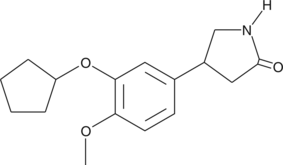Chemicals
Showing 451–600 of 41137 results
-
JWH 073 is a potent cannabimimetic that has been identified as an adulterant in smoking mixtures. JWH 073 N-(3-hydroxybutyl) metabolite is expected to be produced during the metabolism of JWH 073 by human liver microsomes in vitro, generated by the oxidation of the aminoalkyl chain.{19353,18292} The biological actions of this metabolite are unknown.
Brand:CaymanSKU:10795 - 10 mgAvailable on backorder
JWH 073 is a potent cannabimimetic that has been identified as an adulterant in smoking mixtures. JWH 073 N-(3-hydroxybutyl) metabolite is expected to be produced during the metabolism of JWH 073 by human liver microsomes in vitro, generated by the oxidation of the aminoalkyl chain.{19353,18292} The biological actions of this metabolite are unknown.
Brand:CaymanSKU:10795 - 5 mgAvailable on backorder
(±)-JWH 073 N-(3-hydroxybutyl) metabolite-d5 contains five deuterium atoms at the 2, 4, 5, 6, and 7 positions. It is intended for use as an internal standard for the quantification of (±)-JWH 073 N-(3-hydroxybutyl) metabolite by GC- or LC-mass spectrometry (MS). JWH 073 is a potent cannabimimetic that has been identified as an adulterant in smoking mixtures. JWH 073 N-(3-hydroxybutyl) metabolite is expected to be produced by hepatic metabolism of JWH 073.{19353,18292} The biological actions of this metabolite are unknown.
Brand:CaymanSKU:10927 - 1 mgAvailable on backorder
(±)-JWH 073 N-(3-hydroxybutyl) metabolite-d5 contains five deuterium atoms at the 2, 4, 5, 6, and 7 positions. It is intended for use as an internal standard for the quantification of (±)-JWH 073 N-(3-hydroxybutyl) metabolite by GC- or LC-mass spectrometry (MS). JWH 073 is a potent cannabimimetic that has been identified as an adulterant in smoking mixtures. JWH 073 N-(3-hydroxybutyl) metabolite is expected to be produced by hepatic metabolism of JWH 073.{19353,18292} The biological actions of this metabolite are unknown.
Brand:CaymanSKU:10927 - 100 µgAvailable on backorder
(±)-JWH 073 N-(3-hydroxybutyl) metabolite-d5 contains five deuterium atoms at the 2, 4, 5, 6, and 7 positions. It is intended for use as an internal standard for the quantification of (±)-JWH 073 N-(3-hydroxybutyl) metabolite by GC- or LC-mass spectrometry (MS). JWH 073 is a potent cannabimimetic that has been identified as an adulterant in smoking mixtures. JWH 073 N-(3-hydroxybutyl) metabolite is expected to be produced by hepatic metabolism of JWH 073.{19353,18292} The biological actions of this metabolite are unknown.
Brand:CaymanSKU:10927 - 500 µgAvailable on backorder
(±)-Ketoprofen is a non-selective COX inhibitor and non-steroidal anti-inflammatory drug (NSAID).{1286} It inhibits human recombinant COX-1 and COX-2 with IC50 values of 0.5 and 2.33 µM, respectively. In vivo, (±)-ketoprofen reduces carrageenan-induced paw edema and increases latency to paw withdrawal in the hot plate test in rats when administered using a sustained-release implant.{42815} Formulations containing (±)-ketoprofen have been used to treat pain and inflammation in osteoarthritis.
Brand:CaymanSKU:10006661 - 1 gAvailable on backorder
(±)-Ketoprofen is a non-selective COX inhibitor and non-steroidal anti-inflammatory drug (NSAID).{1286} It inhibits human recombinant COX-1 and COX-2 with IC50 values of 0.5 and 2.33 µM, respectively. In vivo, (±)-ketoprofen reduces carrageenan-induced paw edema and increases latency to paw withdrawal in the hot plate test in rats when administered using a sustained-release implant.{42815} Formulations containing (±)-ketoprofen have been used to treat pain and inflammation in osteoarthritis.
Brand:CaymanSKU:10006661 - 10 gAvailable on backorder
(±)-Ketoprofen is a non-selective COX inhibitor and non-steroidal anti-inflammatory drug (NSAID).{1286} It inhibits human recombinant COX-1 and COX-2 with IC50 values of 0.5 and 2.33 µM, respectively. In vivo, (±)-ketoprofen reduces carrageenan-induced paw edema and increases latency to paw withdrawal in the hot plate test in rats when administered using a sustained-release implant.{42815} Formulations containing (±)-ketoprofen have been used to treat pain and inflammation in osteoarthritis.
Brand:CaymanSKU:10006661 - 25 gAvailable on backorder
(±)-Ketoprofen is a non-selective COX inhibitor and non-steroidal anti-inflammatory drug (NSAID).{1286} It inhibits human recombinant COX-1 and COX-2 with IC50 values of 0.5 and 2.33 µM, respectively. In vivo, (±)-ketoprofen reduces carrageenan-induced paw edema and increases latency to paw withdrawal in the hot plate test in rats when administered using a sustained-release implant.{42815} Formulations containing (±)-ketoprofen have been used to treat pain and inflammation in osteoarthritis.
Brand:CaymanSKU:10006661 - 5 gAvailable on backorder
(±)-Ketoprofen glucuronide is a phase II metabolite of the non-steroidal anti-inflammatory drug (NSAID) ketoprofen (Item No. 10006661).{46203} It is formed via glucuronidation by the UDP-glucuronosyltrasferase (UGT) isoforms UGT1A3, UGT1A9, UGT1A10, and UGT2B7.
Brand:CaymanSKU:27180 - 1 mgAvailable on backorder
(±)-Ketoprofen-d3 is intended for use as an internal standard for the quantification of (±)-ketoprofen (Item No. 10006661) by GC- or LC-MS. (±)-Ketoprofen is a non-selective COX inhibitor and non-steroidal anti-inflammatory drug (NSAID).{1286} It inhibits human recombinant COX-1 and COX-2 with IC50 values of 0.5 and 2.33 µM, respectively. In vivo, (±)-ketoprofen reduces carrageenan-induced paw edema and increases latency to paw withdrawal in the hot plate test in rats when administered using a sustained-release implant.{42815} Formulations containing (±)-ketoprofen have been used to treat pain and inflammation in osteoarthritis.
Brand:CaymanSKU:28148 - 1 mgAvailable on backorder
(±)-Ketoprofen-d3 is intended for use as an internal standard for the quantification of (±)-ketoprofen (Item No. 10006661) by GC- or LC-MS. (±)-Ketoprofen is a non-selective COX inhibitor and non-steroidal anti-inflammatory drug (NSAID).{1286} It inhibits human recombinant COX-1 and COX-2 with IC50 values of 0.5 and 2.33 µM, respectively. In vivo, (±)-ketoprofen reduces carrageenan-induced paw edema and increases latency to paw withdrawal in the hot plate test in rats when administered using a sustained-release implant.{42815} Formulations containing (±)-ketoprofen have been used to treat pain and inflammation in osteoarthritis.
Brand:CaymanSKU:28148 - 500 µgAvailable on backorder
(±)-Limonene is a cyclic monoterpene that has been found in various plant oils and Cannabis and has antifungal activity.{42271,47017,47018,47019} It completely inhibits mycelial growth and aflatoxin B1 (Item No. 11293) production in A. flavus when used at concentrations of 500 and 250 ppm, respectively.{47017} (±)-Limonene also inhibits the growth of various additional fungi in vitro, including S. cerevisiae, R. glutinis, and K. thermotolerans (MICs = 500-4,000 μg/ml).{47019} It has been identified as a contact dermatitis allergen in honing oil, paint thinner, and turpentine.{47020,47021,47018} Formulations containing (±)-limonene have been used as fragrance and flavoring ingredients.
Brand:CaymanSKU:25773 - 1 mgAvailable on backorder
(±)-Limonene is a cyclic monoterpene that has been found in various plant oils and Cannabis and has antifungal activity.{42271,47017,47018,47019} It completely inhibits mycelial growth and aflatoxin B1 (Item No. 11293) production in A. flavus when used at concentrations of 500 and 250 ppm, respectively.{47017} (±)-Limonene also inhibits the growth of various additional fungi in vitro, including S. cerevisiae, R. glutinis, and K. thermotolerans (MICs = 500-4,000 μg/ml).{47019} It has been identified as a contact dermatitis allergen in honing oil, paint thinner, and turpentine.{47020,47021,47018} Formulations containing (±)-limonene have been used as fragrance and flavoring ingredients.
Brand:CaymanSKU:25773 - 5 mgAvailable on backorder
(±)-Linalool is a monoterpene alcohol that has been found in C. sativa, C. indica, and hemp with diverse biological activities.{41453,21575,36770,36771,36772,42327} It induces cell cycle arrest at the G0/G1 and G2M phase in U937 and HeLa cells, respectively.{21575} (±)-Linalool is cytotoxic to U937 and HeLa cells (IC50s = 2.59 and 11.02 μM, respectively). It induces recruitment of a PGC-1α coactivator peptide to the PPARα ligand binding domain (EC50 = 5.45 μM in a TR-FRET assay).{36770} In vivo, (±)-linalool reduces plasma triglyceride concentration in mice fed a Western diet and transgenic mice expressing human ApoE2, but not PPARα-/- mice. It has molluscicidal and larvicidal effects in vitro (LC50s = 0.25 and 0.07 mg/L for O. hupensis and S. japonicium, respectively), and it reduces the amount of schitosomulum recovered from mouse skin after S. japonicium challenge infection.{36771} (±)-Linalool (10-40 mg/kg) reduces the number of macrophages and neutrophils and the production of TNF-α, IL-6, IL-1β, IL-8, and MCP-1 in bronchoalveolar lavage fluid (BALF) in a mouse model of cigarette smoke-induced acute lung inflammation.{36772} It also decreases immobility time in the forced swim test in mice, indicating antidepressant-like activity.{42327}
Brand:CaymanSKU:21575 -Out of stock
(±)-Linalool is a monoterpene alcohol that has been found in C. sativa, C. indica, and hemp with diverse biological activities.{41453,21575,36770,36771,36772,42327} It induces cell cycle arrest at the G0/G1 and G2M phase in U937 and HeLa cells, respectively.{21575} (±)-Linalool is cytotoxic to U937 and HeLa cells (IC50s = 2.59 and 11.02 μM, respectively). It induces recruitment of a PGC-1α coactivator peptide to the PPARα ligand binding domain (EC50 = 5.45 μM in a TR-FRET assay).{36770} In vivo, (±)-linalool reduces plasma triglyceride concentration in mice fed a Western diet and transgenic mice expressing human ApoE2, but not PPARα-/- mice. It has molluscicidal and larvicidal effects in vitro (LC50s = 0.25 and 0.07 mg/L for O. hupensis and S. japonicium, respectively), and it reduces the amount of schitosomulum recovered from mouse skin after S. japonicium challenge infection.{36771} (±)-Linalool (10-40 mg/kg) reduces the number of macrophages and neutrophils and the production of TNF-α, IL-6, IL-1β, IL-8, and MCP-1 in bronchoalveolar lavage fluid (BALF) in a mouse model of cigarette smoke-induced acute lung inflammation.{36772} It also decreases immobility time in the forced swim test in mice, indicating antidepressant-like activity.{42327}
Brand:CaymanSKU:21575 -Out of stock
(±)-Linalool is a monoterpene alcohol that has been found in C. sativa, C. indica, and hemp with diverse biological activities.{41453,21575,36770,36771,36772,42327} It induces cell cycle arrest at the G0/G1 and G2M phase in U937 and HeLa cells, respectively.{21575} (±)-Linalool is cytotoxic to U937 and HeLa cells (IC50s = 2.59 and 11.02 μM, respectively). It induces recruitment of a PGC-1α coactivator peptide to the PPARα ligand binding domain (EC50 = 5.45 μM in a TR-FRET assay).{36770} In vivo, (±)-linalool reduces plasma triglyceride concentration in mice fed a Western diet and transgenic mice expressing human ApoE2, but not PPARα-/- mice. It has molluscicidal and larvicidal effects in vitro (LC50s = 0.25 and 0.07 mg/L for O. hupensis and S. japonicium, respectively), and it reduces the amount of schitosomulum recovered from mouse skin after S. japonicium challenge infection.{36771} (±)-Linalool (10-40 mg/kg) reduces the number of macrophages and neutrophils and the production of TNF-α, IL-6, IL-1β, IL-8, and MCP-1 in bronchoalveolar lavage fluid (BALF) in a mouse model of cigarette smoke-induced acute lung inflammation.{36772} It also decreases immobility time in the forced swim test in mice, indicating antidepressant-like activity.{42327}
Brand:CaymanSKU:21575 -Out of stock
(±)-Linalool is a monoterpene alcohol that has been found in C. sativa, C. indica, and hemp with diverse biological activities.{41453,21575,36770,36771,36772,42327} It induces cell cycle arrest at the G0/G1 and G2M phase in U937 and HeLa cells, respectively.{21575} (±)-Linalool is cytotoxic to U937 and HeLa cells (IC50s = 2.59 and 11.02 μM, respectively). It induces recruitment of a PGC-1α coactivator peptide to the PPARα ligand binding domain (EC50 = 5.45 μM in a TR-FRET assay).{36770} In vivo, (±)-linalool reduces plasma triglyceride concentration in mice fed a Western diet and transgenic mice expressing human ApoE2, but not PPARα-/- mice. It has molluscicidal and larvicidal effects in vitro (LC50s = 0.25 and 0.07 mg/L for O. hupensis and S. japonicium, respectively), and it reduces the amount of schitosomulum recovered from mouse skin after S. japonicium challenge infection.{36771} (±)-Linalool (10-40 mg/kg) reduces the number of macrophages and neutrophils and the production of TNF-α, IL-6, IL-1β, IL-8, and MCP-1 in bronchoalveolar lavage fluid (BALF) in a mouse model of cigarette smoke-induced acute lung inflammation.{36772} It also decreases immobility time in the forced swim test in mice, indicating antidepressant-like activity.{42327}
Brand:CaymanSKU:21575 -Out of stock
(±)-Liquiritigenin is a flavonoid that has been found in P. floribundum and has anticancer activity.{46590} It is cytotoxic to HL-60, HCT8, and B16 cancer cell lines (IC50s = 22.5, 19.5, and 5 μg/ml, respectively).
Brand:CaymanSKU:28823 - 100 mgAvailable on backorder
(±)-Liquiritigenin is a flavonoid that has been found in P. floribundum and has anticancer activity.{46590} It is cytotoxic to HL-60, HCT8, and B16 cancer cell lines (IC50s = 22.5, 19.5, and 5 μg/ml, respectively).
Brand:CaymanSKU:28823 - 25 mgAvailable on backorder
(±)-Liquiritigenin is a flavonoid that has been found in P. floribundum and has anticancer activity.{46590} It is cytotoxic to HL-60, HCT8, and B16 cancer cell lines (IC50s = 22.5, 19.5, and 5 μg/ml, respectively).
Brand:CaymanSKU:28823 - 250 mgAvailable on backorder
(±)-Liquiritigenin is a flavonoid that has been found in P. floribundum and has anticancer activity.{46590} It is cytotoxic to HL-60, HCT8, and B16 cancer cell lines (IC50s = 22.5, 19.5, and 5 μg/ml, respectively).
Brand:CaymanSKU:28823 - 50 mgAvailable on backorder
(±)-Menthol is a racemic mixture of the monoterpene alcohols (–)-menthol and (+)-menthol (Item No. 23463), which have been found in Cannabis.{42303} (–)-Menthol is more common than (+)-menthol in nature and exhibits analgesic, antibacterial, and anticancer properties, as well as inhibits cholinesterase.{42361} (+)-Menthol inhibits the growth of F. verticillioides (MIC = 1.5 mM) but, unlike (–)-menthol, does not exhibit analgesic, antibacterial, anticancer, or cholinesterase inhibitory activities.{42361,42360}
Brand:CaymanSKU:25753 - 10 gAvailable on backorder
(±)-Menthol is a racemic mixture of the monoterpene alcohols (–)-menthol and (+)-menthol (Item No. 23463), which have been found in Cannabis.{42303} (–)-Menthol is more common than (+)-menthol in nature and exhibits analgesic, antibacterial, and anticancer properties, as well as inhibits cholinesterase.{42361} (+)-Menthol inhibits the growth of F. verticillioides (MIC = 1.5 mM) but, unlike (–)-menthol, does not exhibit analgesic, antibacterial, anticancer, or cholinesterase inhibitory activities.{42361,42360}
Brand:CaymanSKU:25753 - 25 gAvailable on backorder
(±)-Menthol is a racemic mixture of the monoterpene alcohols (–)-menthol and (+)-menthol (Item No. 23463), which have been found in Cannabis.{42303} (–)-Menthol is more common than (+)-menthol in nature and exhibits analgesic, antibacterial, and anticancer properties, as well as inhibits cholinesterase.{42361} (+)-Menthol inhibits the growth of F. verticillioides (MIC = 1.5 mM) but, unlike (–)-menthol, does not exhibit analgesic, antibacterial, anticancer, or cholinesterase inhibitory activities.{42361,42360}
Brand:CaymanSKU:25753 - 5 gAvailable on backorder
(±)-Methoxyverapamil is a phenylalkylamine L-type calcium channel blocker and methoxy derivative of verapamil (Item No. 14288).{38991} (±)-Methoxyverapamil blocks recombinant rat L-type calcium channels expressed in tsA201 cells with IC50 values of 782 and 8,000 nM at holding potentials of 10 and -60 mV, respectively. It blocks maitotoxin-induced calcium influx in NIH3T3 fibroblasts (IC50 = 16 μM) and inhibits histamine-induced acid secretion by primary enriched guinea pig parietal cells (IC50 = 10.9 μM).{38992,38993} (±)-Methoxyverapamil binds to rat myocardial membranes (IC50 = 16 nM) and inhibits electrically-stimulated contractions in rat right myocardial ventricular strips (EC50 = 1.95 μM).{38994} In conscious, ovariectomized, post-partum rats, it decreases blood pressure by 30 mm Hg and induces 60% inhibition of uterine contractions when administered at doses of 204 and 324 μg/kg, respectively.{38995}
Brand:CaymanSKU:24270 - 10 mgAvailable on backorder
(±)-Methoxyverapamil is a phenylalkylamine L-type calcium channel blocker and methoxy derivative of verapamil (Item No. 14288).{38991} (±)-Methoxyverapamil blocks recombinant rat L-type calcium channels expressed in tsA201 cells with IC50 values of 782 and 8,000 nM at holding potentials of 10 and -60 mV, respectively. It blocks maitotoxin-induced calcium influx in NIH3T3 fibroblasts (IC50 = 16 μM) and inhibits histamine-induced acid secretion by primary enriched guinea pig parietal cells (IC50 = 10.9 μM).{38992,38993} (±)-Methoxyverapamil binds to rat myocardial membranes (IC50 = 16 nM) and inhibits electrically-stimulated contractions in rat right myocardial ventricular strips (EC50 = 1.95 μM).{38994} In conscious, ovariectomized, post-partum rats, it decreases blood pressure by 30 mm Hg and induces 60% inhibition of uterine contractions when administered at doses of 204 and 324 μg/kg, respectively.{38995}
Brand:CaymanSKU:24270 - 25 mgAvailable on backorder
(±)-Methoxyverapamil is a phenylalkylamine L-type calcium channel blocker and methoxy derivative of verapamil (Item No. 14288).{38991} (±)-Methoxyverapamil blocks recombinant rat L-type calcium channels expressed in tsA201 cells with IC50 values of 782 and 8,000 nM at holding potentials of 10 and -60 mV, respectively. It blocks maitotoxin-induced calcium influx in NIH3T3 fibroblasts (IC50 = 16 μM) and inhibits histamine-induced acid secretion by primary enriched guinea pig parietal cells (IC50 = 10.9 μM).{38992,38993} (±)-Methoxyverapamil binds to rat myocardial membranes (IC50 = 16 nM) and inhibits electrically-stimulated contractions in rat right myocardial ventricular strips (EC50 = 1.95 μM).{38994} In conscious, ovariectomized, post-partum rats, it decreases blood pressure by 30 mm Hg and induces 60% inhibition of uterine contractions when administered at doses of 204 and 324 μg/kg, respectively.{38995}
Brand:CaymanSKU:24270 - 5 mgAvailable on backorder
(±)-Methoxyverapamil is a phenylalkylamine L-type calcium channel blocker and methoxy derivative of verapamil (Item No. 14288).{38991} (±)-Methoxyverapamil blocks recombinant rat L-type calcium channels expressed in tsA201 cells with IC50 values of 782 and 8,000 nM at holding potentials of 10 and -60 mV, respectively. It blocks maitotoxin-induced calcium influx in NIH3T3 fibroblasts (IC50 = 16 μM) and inhibits histamine-induced acid secretion by primary enriched guinea pig parietal cells (IC50 = 10.9 μM).{38992,38993} (±)-Methoxyverapamil binds to rat myocardial membranes (IC50 = 16 nM) and inhibits electrically-stimulated contractions in rat right myocardial ventricular strips (EC50 = 1.95 μM).{38994} In conscious, ovariectomized, post-partum rats, it decreases blood pressure by 30 mm Hg and induces 60% inhibition of uterine contractions when administered at doses of 204 and 324 μg/kg, respectively.{38995}
Brand:CaymanSKU:24270 - 50 mgAvailable on backorder
(±)-Muscarine is an agonist of muscarinic acetylcholine receptors that was originally found in A. muscaria.{36535} It induces spasms in isolated intestinal ileum from mouse, guinea pig, rabbit, dog, monkey, and horse, contraction of longitudinal uterine and bladder muscle strips from mouse, guinea pig, rabbit, rat, horse, and dog, and slows the heart rate of isolated guinea pig and rabbit atria. In vivo, (±)-muscarine induces bronchoconstriction in guinea pigs and rabbits as well as respiratory depression in rabbits and cats with minimum active doses (MADs) ranging from 1 to 5 μg/kg. It reduces blood pressure in cats, dogs, and rabbits and induces uterine, bladder, and intestinal contraction in cats and dogs. (±)-Muscarine (0.005-0.01 mg/kg) increases circling and pacing behaviors and induces fear aggression in cats.{36536} It has antinociceptive activity in rats in the hot plate and tail-flick tests.{36537} (±)-Muscarine also inhibits acetylcholinesterase (Ki = 220 μM).{36538}
Brand:CaymanSKU:24269 - 1 mgAvailable on backorder
(±)-Muscarine is an agonist of muscarinic acetylcholine receptors that was originally found in A. muscaria.{36535} It induces spasms in isolated intestinal ileum from mouse, guinea pig, rabbit, dog, monkey, and horse, contraction of longitudinal uterine and bladder muscle strips from mouse, guinea pig, rabbit, rat, horse, and dog, and slows the heart rate of isolated guinea pig and rabbit atria. In vivo, (±)-muscarine induces bronchoconstriction in guinea pigs and rabbits as well as respiratory depression in rabbits and cats with minimum active doses (MADs) ranging from 1 to 5 μg/kg. It reduces blood pressure in cats, dogs, and rabbits and induces uterine, bladder, and intestinal contraction in cats and dogs. (±)-Muscarine (0.005-0.01 mg/kg) increases circling and pacing behaviors and induces fear aggression in cats.{36536} It has antinociceptive activity in rats in the hot plate and tail-flick tests.{36537} (±)-Muscarine also inhibits acetylcholinesterase (Ki = 220 μM).{36538}
Brand:CaymanSKU:24269 - 5 mgAvailable on backorder
(±)-N-3-Benzylnirvanol is a racemic mixture of (+)-N-3-benzylnirvanol and (–)-N-3-benzylnirvanol.{43826,37307} (+)-N-3-benzylnirvanol and (–)-N-3-benzylnirvanol are inhibitors of the cytochrome P450 (CYP) isoform CYP2C19 (Kis = 0.292 and 5.3 μM, respectively).{43826} (±)-N-3-Benzylnirvanol (20 mg/kg, i.p.) lowers plasma levels of cholesterol in mice.{37307}
Brand:CaymanSKU:27298 - 1 mgAvailable on backorder
(±)-N-3-Benzylnirvanol is a racemic mixture of (+)-N-3-benzylnirvanol and (–)-N-3-benzylnirvanol.{43826,37307} (+)-N-3-benzylnirvanol and (–)-N-3-benzylnirvanol are inhibitors of the cytochrome P450 (CYP) isoform CYP2C19 (Kis = 0.292 and 5.3 μM, respectively).{43826} (±)-N-3-Benzylnirvanol (20 mg/kg, i.p.) lowers plasma levels of cholesterol in mice.{37307}
Brand:CaymanSKU:27298 - 10 mgAvailable on backorder
(±)-N-3-Benzylnirvanol is a racemic mixture of (+)-N-3-benzylnirvanol and (–)-N-3-benzylnirvanol.{43826,37307} (+)-N-3-benzylnirvanol and (–)-N-3-benzylnirvanol are inhibitors of the cytochrome P450 (CYP) isoform CYP2C19 (Kis = 0.292 and 5.3 μM, respectively).{43826} (±)-N-3-Benzylnirvanol (20 mg/kg, i.p.) lowers plasma levels of cholesterol in mice.{37307}
Brand:CaymanSKU:27298 - 5 mgAvailable on backorder
(±)-Naproxen-d3 is intended for use as an internal standard for the quantification of naproxen by GC- or LC-MS. (±)-Naproxen is a racemic mixture of (+)-naproxen (Item No. 70290) and (–)-naproxen.
Brand:CaymanSKU:-Available on backorder
(±)-Naproxen-d3 is intended for use as an internal standard for the quantification of naproxen by GC- or LC-MS. (±)-Naproxen is a racemic mixture of (+)-naproxen (Item No. 70290) and (–)-naproxen.
Brand:CaymanSKU:-Available on backorder
(±)-Necrostatin-2 is a racemic mixture that inhibits receptor-interacting protein kinase 1 (RIPK1) autophosphorylation in vitro in a dose-dependent manner.{33477} Treatment with 6 mg/kg/day of (±)-necrostatin-2 prevents TNF-induced mortality in a murine model of systemic inflammatory response syndrome (SIRS). (±)-Necrostatin-2 decreases irradiation-induced lactate dehydrogenase (LDH) release and cell death in murine embryonic Cyt c-/- cells.{38080} It also prevents angiotensin II-induced elastin degradation and aortic inflammation in a murine abdominal aortic aneurism (AAA) model at a dose of 1.6 mg/kg/day.
Brand:CaymanSKU:20924 -Out of stock
(±)-Necrostatin-2 is a racemic mixture that inhibits receptor-interacting protein kinase 1 (RIPK1) autophosphorylation in vitro in a dose-dependent manner.{33477} Treatment with 6 mg/kg/day of (±)-necrostatin-2 prevents TNF-induced mortality in a murine model of systemic inflammatory response syndrome (SIRS). (±)-Necrostatin-2 decreases irradiation-induced lactate dehydrogenase (LDH) release and cell death in murine embryonic Cyt c-/- cells.{38080} It also prevents angiotensin II-induced elastin degradation and aortic inflammation in a murine abdominal aortic aneurism (AAA) model at a dose of 1.6 mg/kg/day.
Brand:CaymanSKU:20924 -Out of stock
(±)-Necrostatin-2 is a racemic mixture that inhibits receptor-interacting protein kinase 1 (RIPK1) autophosphorylation in vitro in a dose-dependent manner.{33477} Treatment with 6 mg/kg/day of (±)-necrostatin-2 prevents TNF-induced mortality in a murine model of systemic inflammatory response syndrome (SIRS). (±)-Necrostatin-2 decreases irradiation-induced lactate dehydrogenase (LDH) release and cell death in murine embryonic Cyt c-/- cells.{38080} It also prevents angiotensin II-induced elastin degradation and aortic inflammation in a murine abdominal aortic aneurism (AAA) model at a dose of 1.6 mg/kg/day.
Brand:CaymanSKU:20924 -Out of stock
(±)-Nicotine is the racemic mixture of the dominant alkaloid found in tobacco plants. It acts as an agonist at neuronal nicotinic acetylcholine receptors (nAChRs; Kis = 481 and 11.1 nM for α3β4 and α4β2 subtypes, respectively) and possesses addictive and teratogenic properties.{18814} (−)-(S)-Nicotine is significantly more active at binding nAChRs compared to the (+)-(R) antipode, thus nicotine is typically synthesized as (−)-(S)-nicotine with only 0.2-1% of the (+)-(R) isomer present.{26727}
Brand:CaymanSKU:-Out of stock
(±)-Nicotine is the racemic mixture of the dominant alkaloid found in tobacco plants. It acts as an agonist at neuronal nicotinic acetylcholine receptors (nAChRs; Kis = 481 and 11.1 nM for α3β4 and α4β2 subtypes, respectively) and possesses addictive and teratogenic properties.{18814} (−)-(S)-Nicotine is significantly more active at binding nAChRs compared to the (+)-(R) antipode, thus nicotine is typically synthesized as (−)-(S)-nicotine with only 0.2-1% of the (+)-(R) isomer present.{26727}
Brand:CaymanSKU:-Out of stock
(±)-Nicotine is the racemic mixture of the dominant alkaloid found in tobacco plants. It acts as an agonist at neuronal nicotinic acetylcholine receptors (nAChRs; Kis = 481 and 11.1 nM for α3β4 and α4β2 subtypes, respectively) and possesses addictive and teratogenic properties.{18814} (−)-(S)-Nicotine is significantly more active at binding nAChRs compared to the (+)-(R) antipode, thus nicotine is typically synthesized as (−)-(S)-nicotine with only 0.2-1% of the (+)-(R) isomer present.{26727}
Brand:CaymanSKU:-Out of stock
(±)-Nicotine-d3 is intended for use as an internal standard for the quantification of (±)-nicotine (Item No. 16535) by GC- or LC-mass spectrometry. (±)-Nicotine is the racemic mixture of the dominant alkaloid found in tobacco plants. It acts as an agonist at neuronal nicotinic acetylcholine receptors (nAChRs; Kis = 481 and 11.1 nM for α3β4 and α4β2 subtypes, respectively) and possesses addictive and teratogenic properties.{18814} (−)-(S)-Nicotine is significantly more active at binding nAChRs compared to the (+)-(R) antipode, thus nicotine is typically synthesized as (−)-(S)-nicotine with only 0.2-1% of the (+)-(R) isomer present.{26727}
Brand:CaymanSKU:-Available on backorder
(±)-Nicotine-d3 is intended for use as an internal standard for the quantification of (±)-nicotine (Item No. 16535) by GC- or LC-mass spectrometry. (±)-Nicotine is the racemic mixture of the dominant alkaloid found in tobacco plants. It acts as an agonist at neuronal nicotinic acetylcholine receptors (nAChRs; Kis = 481 and 11.1 nM for α3β4 and α4β2 subtypes, respectively) and possesses addictive and teratogenic properties.{18814} (−)-(S)-Nicotine is significantly more active at binding nAChRs compared to the (+)-(R) antipode, thus nicotine is typically synthesized as (−)-(S)-nicotine with only 0.2-1% of the (+)-(R) isomer present.{26727}
Brand:CaymanSKU:-Available on backorder
(±)-Nicotine-d3 is intended for use as an internal standard for the quantification of (±)-nicotine (Item No. 16535) by GC- or LC-mass spectrometry. (±)-Nicotine is the racemic mixture of the dominant alkaloid found in tobacco plants. It acts as an agonist at neuronal nicotinic acetylcholine receptors (nAChRs; Kis = 481 and 11.1 nM for α3β4 and α4β2 subtypes, respectively) and possesses addictive and teratogenic properties.{18814} (−)-(S)-Nicotine is significantly more active at binding nAChRs compared to the (+)-(R) antipode, thus nicotine is typically synthesized as (−)-(S)-nicotine with only 0.2-1% of the (+)-(R) isomer present.{26727}
Brand:CaymanSKU:-Available on backorder
(±)-Nicotine-d3 is intended for use as an internal standard for the quantification of (±)-nicotine (Item No. 16535) by GC- or LC-mass spectrometry. (±)-Nicotine is the racemic mixture of the dominant alkaloid found in tobacco plants. It acts as an agonist at neuronal nicotinic acetylcholine receptors (nAChRs; Kis = 481 and 11.1 nM for α3β4 and α4β2 subtypes, respectively) and possesses addictive and teratogenic properties.{18814} (−)-(S)-Nicotine is significantly more active at binding nAChRs compared to the (+)-(R) antipode, thus nicotine is typically synthesized as (−)-(S)-nicotine with only 0.2-1% of the (+)-(R) isomer present.{26727}
Brand:CaymanSKU:-Available on backorder
(±)-NLG-919 is an indoleamine 2,3-dioxygenase (IDO) pathway inhibitor (Ki = 7 nM; EC50 = 75 nM).{38170} (±)-NLG-919 inhibits IDO-induced T cell suppression and restores T cell response during allogenic mixed lymphocyte reactions in vitro (ED50s = 80 and 120 nM, respectively). In vivo, (±)-NLG-919 induces a 95% reduction in tumor volume when administered in conjunction with a pmel-1 T cell vaccine. Formulations containing (±)-NLG-919 are under investigation in clinical trials for treatment of glioblastoma, melanoma, pancreatic, and breast cancers.{38171}
Brand:CaymanSKU:21509 -Out of stock
(±)-NLG-919 is an indoleamine 2,3-dioxygenase (IDO) pathway inhibitor (Ki = 7 nM; EC50 = 75 nM).{38170} (±)-NLG-919 inhibits IDO-induced T cell suppression and restores T cell response during allogenic mixed lymphocyte reactions in vitro (ED50s = 80 and 120 nM, respectively). In vivo, (±)-NLG-919 induces a 95% reduction in tumor volume when administered in conjunction with a pmel-1 T cell vaccine. Formulations containing (±)-NLG-919 are under investigation in clinical trials for treatment of glioblastoma, melanoma, pancreatic, and breast cancers.{38171}
Brand:CaymanSKU:21509 -Out of stock
(±)-NLG-919 is an indoleamine 2,3-dioxygenase (IDO) pathway inhibitor (Ki = 7 nM; EC50 = 75 nM).{38170} (±)-NLG-919 inhibits IDO-induced T cell suppression and restores T cell response during allogenic mixed lymphocyte reactions in vitro (ED50s = 80 and 120 nM, respectively). In vivo, (±)-NLG-919 induces a 95% reduction in tumor volume when administered in conjunction with a pmel-1 T cell vaccine. Formulations containing (±)-NLG-919 are under investigation in clinical trials for treatment of glioblastoma, melanoma, pancreatic, and breast cancers.{38171}
Brand:CaymanSKU:21509 -Out of stock
(±)-NLG-919 is an indoleamine 2,3-dioxygenase (IDO) pathway inhibitor (Ki = 7 nM; EC50 = 75 nM).{38170} (±)-NLG-919 inhibits IDO-induced T cell suppression and restores T cell response during allogenic mixed lymphocyte reactions in vitro (ED50s = 80 and 120 nM, respectively). In vivo, (±)-NLG-919 induces a 95% reduction in tumor volume when administered in conjunction with a pmel-1 T cell vaccine. Formulations containing (±)-NLG-919 are under investigation in clinical trials for treatment of glioblastoma, melanoma, pancreatic, and breast cancers.{38171}
Brand:CaymanSKU:21509 -Out of stock
(±)-Nornicotine is a metabolite of nicotine (Item No. 16535) that acts as a neuronal nicotinic acetylcholine receptor (nAChR) agonist. The α6 and α7 subunit-containing neuronal nAChRs are particularly responsive to nornicotine with EC50 values of approximately 4 and 17 µM, respectively, when expressed in Xenopus oocytes.{34465} Nornicotine promotes cell migration and destabilizes cell-cell junctions in an endothelial cell line.{34463} It is generally thought to be free from abuse potential, but it has been self-administered by rats.{34462,34464} It can be detected in urine.{34466}
Brand:CaymanSKU:20505 -Available on backorder
(±)-Nornicotine is a metabolite of nicotine (Item No. 16535) that acts as a neuronal nicotinic acetylcholine receptor (nAChR) agonist. The α6 and α7 subunit-containing neuronal nAChRs are particularly responsive to nornicotine with EC50 values of approximately 4 and 17 µM, respectively, when expressed in Xenopus oocytes.{34465} Nornicotine promotes cell migration and destabilizes cell-cell junctions in an endothelial cell line.{34463} It is generally thought to be free from abuse potential, but it has been self-administered by rats.{34462,34464} It can be detected in urine.{34466}
Brand:CaymanSKU:20505 -Available on backorder
(±)-Nornicotine is a metabolite of nicotine (Item No. 16535) that acts as a neuronal nicotinic acetylcholine receptor (nAChR) agonist. The α6 and α7 subunit-containing neuronal nAChRs are particularly responsive to nornicotine with EC50 values of approximately 4 and 17 µM, respectively, when expressed in Xenopus oocytes.{34465} Nornicotine promotes cell migration and destabilizes cell-cell junctions in an endothelial cell line.{34463} It is generally thought to be free from abuse potential, but it has been self-administered by rats.{34462,34464} It can be detected in urine.{34466}
Brand:CaymanSKU:20505 -Available on backorder
(±)-Nornicotine is a metabolite of nicotine (Item No. 16535) that acts as a neuronal nicotinic acetylcholine receptor (nAChR) agonist. The α6 and α7 subunit-containing neuronal nAChRs are particularly responsive to nornicotine with EC50 values of approximately 4 and 17 µM, respectively, when expressed in Xenopus oocytes.{34465} Nornicotine promotes cell migration and destabilizes cell-cell junctions in an endothelial cell line.{34463} It is generally thought to be free from abuse potential, but it has been self-administered by rats.{34462,34464} It can be detected in urine.{34466}
Brand:CaymanSKU:20505 -Available on backorder
The protein p53, often called the ‘guardian of the genome,’ is a transcription factor that is activated in response to cellular stress (low oxygen levels, heat shock, DNA damage, etc.) and acts to prevent further proliferation of the stressed cell by promoting cell cycle arrest or apoptosis.{8237,11275} Its role as a tumor suppressor is evident by the observation that approximately 50% of human tumors have mutated or non-functional p53. Mdm2, a key negative regulator of p53 which is over-expressed in many human tumors, functions by binding to and targeting p53 for proteasomal degradation. Nutlin-3 inhibits p53-Mdm2 interaction with a IC50 of 0.09 µM.{11628} It induces the expression of p53-regulated genes and exhibits potent antiproliferative activity in cells with functional p53, but not in cells with mutated p53. Nutlin-3 also inhibits the growth of human tumor xenografts in nude mice by 90% at a dose of 200 mg/kg.{11628}
Brand:CaymanSKU:10004372 - 1 mgAvailable on backorder
The protein p53, often called the ‘guardian of the genome,’ is a transcription factor that is activated in response to cellular stress (low oxygen levels, heat shock, DNA damage, etc.) and acts to prevent further proliferation of the stressed cell by promoting cell cycle arrest or apoptosis.{8237,11275} Its role as a tumor suppressor is evident by the observation that approximately 50% of human tumors have mutated or non-functional p53. Mdm2, a key negative regulator of p53 which is over-expressed in many human tumors, functions by binding to and targeting p53 for proteasomal degradation. Nutlin-3 inhibits p53-Mdm2 interaction with a IC50 of 0.09 µM.{11628} It induces the expression of p53-regulated genes and exhibits potent antiproliferative activity in cells with functional p53, but not in cells with mutated p53. Nutlin-3 also inhibits the growth of human tumor xenografts in nude mice by 90% at a dose of 200 mg/kg.{11628}
Brand:CaymanSKU:10004372 - 10 mgAvailable on backorder
The protein p53, often called the ‘guardian of the genome,’ is a transcription factor that is activated in response to cellular stress (low oxygen levels, heat shock, DNA damage, etc.) and acts to prevent further proliferation of the stressed cell by promoting cell cycle arrest or apoptosis.{8237,11275} Its role as a tumor suppressor is evident by the observation that approximately 50% of human tumors have mutated or non-functional p53. Mdm2, a key negative regulator of p53 which is over-expressed in many human tumors, functions by binding to and targeting p53 for proteasomal degradation. Nutlin-3 inhibits p53-Mdm2 interaction with a IC50 of 0.09 µM.{11628} It induces the expression of p53-regulated genes and exhibits potent antiproliferative activity in cells with functional p53, but not in cells with mutated p53. Nutlin-3 also inhibits the growth of human tumor xenografts in nude mice by 90% at a dose of 200 mg/kg.{11628}
Brand:CaymanSKU:10004372 - 5 mgAvailable on backorder
The protein p53, often called the ‘guardian of the genome,’ is a transcription factor that is activated in response to cellular stress (low oxygen levels, heat shock, DNA damage, etc.) and acts to prevent further proliferation of the stressed cell by promoting cell cycle arrest or apoptosis.{8237,11275} Its role as a tumor suppressor is evident by the observation that approximately 50% of human tumors have mutated or non-functional p53. Mdm2, a key negative regulator of p53 which is over-expressed in many human tumors, functions by binding to and targeting p53 for proteasomal degradation. Nutlin-3 inhibits p53-Mdm2 interaction with a IC50 of 0.09 µM.{11628} It induces the expression of p53-regulated genes and exhibits potent antiproliferative activity in cells with functional p53, but not in cells with mutated p53. Nutlin-3 also inhibits the growth of human tumor xenografts in nude mice by 90% at a dose of 200 mg/kg.{11628}
Brand:CaymanSKU:10004372 - 50 mgAvailable on backorder
(±)-O-Desmethyl venlafaxine is the active metabolite of venlafaxine (Item No. 11567), an inhibitor of the reuptake of both serotonin and norepinephrine.{32154,22995,22994} Venlafaxine is metabolized by cytochrome P450 2D6, yielding O-desmethyl venlafaxine, which is pharmacologically similar to the parent drug.{32155,32156} (±)-O-Desmethyl venlafaxine inhibits the human serotonin and norepinephrine transporters with IC50 values of 47.3 and 531.3 nM, respectively.{32153}
Brand:CaymanSKU:9001881 - 10 mgAvailable on backorder
(±)-O-Desmethyl venlafaxine is the active metabolite of venlafaxine (Item No. 11567), an inhibitor of the reuptake of both serotonin and norepinephrine.{32154,22995,22994} Venlafaxine is metabolized by cytochrome P450 2D6, yielding O-desmethyl venlafaxine, which is pharmacologically similar to the parent drug.{32155,32156} (±)-O-Desmethyl venlafaxine inhibits the human serotonin and norepinephrine transporters with IC50 values of 47.3 and 531.3 nM, respectively.{32153}
Brand:CaymanSKU:9001881 - 25 mgAvailable on backorder
(±)-O-Desmethyl venlafaxine is the active metabolite of venlafaxine (Item No. 11567), an inhibitor of the reuptake of both serotonin and norepinephrine.{32154,22995,22994} Venlafaxine is metabolized by cytochrome P450 2D6, yielding O-desmethyl venlafaxine, which is pharmacologically similar to the parent drug.{32155,32156} (±)-O-Desmethyl venlafaxine inhibits the human serotonin and norepinephrine transporters with IC50 values of 47.3 and 531.3 nM, respectively.{32153}
Brand:CaymanSKU:9001881 - 5 mgAvailable on backorder
(±)-O-Desmethyl venlafaxine is the active metabolite of venlafaxine (Item No. 11567), an inhibitor of the reuptake of both serotonin and norepinephrine.{32154,22995,22994} Venlafaxine is metabolized by cytochrome P450 2D6, yielding O-desmethyl venlafaxine, which is pharmacologically similar to the parent drug.{32155,32156} (±)-O-Desmethyl venlafaxine inhibits the human serotonin and norepinephrine transporters with IC50 values of 47.3 and 531.3 nM, respectively.{32153}
Brand:CaymanSKU:9001881 - 50 mgAvailable on backorder
(±)-O-Desmethyl venlafaxine-d6 (Item No. 15843) is an analytical reference standard intended for use as an internal standard for the quantification of (±)-O-desmethyl venlafaxine by GC- or LC-MS. (±)-O-Desmethyl venlafaxine is a metabolite of the antidepressant venlafaxine (Item Nos. 25524 | 11567).{32155} This product is intended for research and forensic applications.
Brand:CaymanSKU:-(±)-O-Desmethyl venlafaxine-d6 (Item No. 15843) is an analytical reference standard intended for use as an internal standard for the quantification of (±)-O-desmethyl venlafaxine by GC- or LC-MS. (±)-O-Desmethyl venlafaxine is a metabolite of the antidepressant venlafaxine (Item Nos. 25524 | 11567).{32155} This product is intended for research and forensic applications.
Brand:CaymanSKU:-(±)-O-Desmethyl venlafaxine-d6 (Item No. 15843) is an analytical reference standard intended for use as an internal standard for the quantification of (±)-O-desmethyl venlafaxine by GC- or LC-MS. (±)-O-Desmethyl venlafaxine is a metabolite of the antidepressant venlafaxine (Item Nos. 25524 | 11567).{32155} This product is intended for research and forensic applications.
Brand:CaymanSKU:-(±)-O-Desmethyl venlafaxine-d6 (Item No. 15843) is an analytical reference standard intended for use as an internal standard for the quantification of (±)-O-desmethyl venlafaxine by GC- or LC-MS. (±)-O-Desmethyl venlafaxine is a metabolite of the antidepressant venlafaxine (Item Nos. 25524 | 11567).{32155} This product is intended for research and forensic applications.
Brand:CaymanSKU:-(±)-ORG 28611 is the racemic mixture of the water soluble, full agonist of the human cannabinoid (CB) receptors central CB1 (pEC50 = 7.6; pKi = 8.9) and peripheral CB2 (pKi = 8.8).{23926} ORG 28611 (0.1-1 μM/kg, intravenous) demonstrated antinociceptive activity in the mouse tail flick test and the mouse formalin paw test, and it was further evaluated clinically for use as a potential intravenous analgesic agent.{23926}
Brand:CaymanSKU:-(±)-ORG 28611 is the racemic mixture of the water soluble, full agonist of the human cannabinoid (CB) receptors central CB1 (pEC50 = 7.6; pKi = 8.9) and peripheral CB2 (pKi = 8.8).{23926} ORG 28611 (0.1-1 μM/kg, intravenous) demonstrated antinociceptive activity in the mouse tail flick test and the mouse formalin paw test, and it was further evaluated clinically for use as a potential intravenous analgesic agent.{23926}
Brand:CaymanSKU:-(±)-ORG 28611 is the racemic mixture of the water soluble, full agonist of the human cannabinoid (CB) receptors central CB1 (pEC50 = 7.6; pKi = 8.9) and peripheral CB2 (pKi = 8.8).{23926} ORG 28611 (0.1-1 μM/kg, intravenous) demonstrated antinociceptive activity in the mouse tail flick test and the mouse formalin paw test, and it was further evaluated clinically for use as a potential intravenous analgesic agent.{23926}
Brand:CaymanSKU:-(±)-para-Octopamine ((±)-p-Octopamine) is an endogenous biogenic amine commonly found in invertebrates. Structurally similar to norepinephrine, (±)-p-octopamine activates adrenergic-like receptors and evokes effects, in invertebrates, that parallel those of norepinephrine and epinephrine in mammals.{22582,22580} In humans, (±)-p-octopamine is considered a trace amine which may interfere with aminergic pathways as well as signal through trace amine-associated receptors.{22581}
Brand:CaymanSKU:-(±)-para-Octopamine ((±)-p-Octopamine) is an endogenous biogenic amine commonly found in invertebrates. Structurally similar to norepinephrine, (±)-p-octopamine activates adrenergic-like receptors and evokes effects, in invertebrates, that parallel those of norepinephrine and epinephrine in mammals.{22582,22580} In humans, (±)-p-octopamine is considered a trace amine which may interfere with aminergic pathways as well as signal through trace amine-associated receptors.{22581}
Brand:CaymanSKU:-(±)-Propranolol is a β-adrenergic receptor (β-AR) antagonist (Kds = 6.91, 0.832, and 117.49 nM for human β1-, β2-, and β3-ARs, respectively).{25151} It reduces mean blood pressure, resting heart rate, and contractility and increases AV conduction time in dogs.{30090} (±)-Propranolol restores normal sinus rhythm in dogs with ouabain-induced arrhythmias (ED50 = 3.8 mg/kg).{39376} It also acts as a non-specific serotonin receptor antagonist, reducing tranylcypromine/L-tryptophan-induced hyperactivity in rats.{25891} Formulations containing (±)-propranolol have been used for the treatment of hypertension, angina pectoris, and cardiac ischemia.
Brand:CaymanSKU:23349 - 10 gAvailable on backorder
(±)-Propranolol is a β-adrenergic receptor (β-AR) antagonist (Kds = 6.91, 0.832, and 117.49 nM for human β1-, β2-, and β3-ARs, respectively).{25151} It reduces mean blood pressure, resting heart rate, and contractility and increases AV conduction time in dogs.{30090} (±)-Propranolol restores normal sinus rhythm in dogs with ouabain-induced arrhythmias (ED50 = 3.8 mg/kg).{39376} It also acts as a non-specific serotonin receptor antagonist, reducing tranylcypromine/L-tryptophan-induced hyperactivity in rats.{25891} Formulations containing (±)-propranolol have been used for the treatment of hypertension, angina pectoris, and cardiac ischemia.
Brand:CaymanSKU:23349 - 25 gAvailable on backorder
(±)-Propranolol is a β-adrenergic receptor (β-AR) antagonist (Kds = 6.91, 0.832, and 117.49 nM for human β1-, β2-, and β3-ARs, respectively).{25151} It reduces mean blood pressure, resting heart rate, and contractility and increases AV conduction time in dogs.{30090} (±)-Propranolol restores normal sinus rhythm in dogs with ouabain-induced arrhythmias (ED50 = 3.8 mg/kg).{39376} It also acts as a non-specific serotonin receptor antagonist, reducing tranylcypromine/L-tryptophan-induced hyperactivity in rats.{25891} Formulations containing (±)-propranolol have been used for the treatment of hypertension, angina pectoris, and cardiac ischemia.
Brand:CaymanSKU:23349 - 5 gAvailable on backorder
(±)-Propranolol is a β-adrenergic receptor (β-AR) antagonist (Kds = 6.91, 0.832, and 117.49 nM for human β1-, β2-, and β3-ARs, respectively).{25151} It reduces mean blood pressure, resting heart rate, and contractility and increases AV conduction time in dogs.{30090} (±)-Propranolol restores normal sinus rhythm in dogs with ouabain-induced arrhythmias (ED50 = 3.8 mg/kg).{39376} It also acts as a non-specific serotonin receptor antagonist, reducing tranylcypromine/L-tryptophan-induced hyperactivity in rats.{25891} Formulations containing (±)-propranolol have been used for the treatment of hypertension, angina pectoris, and cardiac ischemia.
Brand:CaymanSKU:23349 - 50 gAvailable on backorder
(±)-Propranolol-d7 is intended for use as an internal standard for the quantification of propranolol (Item Nos. 23349 | 17291) by GC- or LC-MS. (±)-Propranolol is a β-adrenergic receptor (β-AR) antagonist (Kds = 6.91, 0.832, and 117.49 nM for human β1-, β2-, and β3-ARs, respectively).{25151} It reduces mean blood pressure, resting heart rate, and contractility and increases AV conduction time in dogs.{30090} (±)-Propranolol restores normal sinus rhythm in dogs with ouabain-induced arrhythmias (ED50 = 3.8 mg/kg).{39376} It also acts as a non-specific serotonin receptor antagonist, reducing tranylcypromine/L-tryptophan-induced hyperactivity in rats.{25891} Formulations containing (±)-propranolol have been used for the treatment of hypertension, angina pectoris, and cardiac ischemia.
Brand:CaymanSKU:25282 - 1 mgAvailable on backorder
(±)-Propranolol-d7 is intended for use as an internal standard for the quantification of propranolol (Item Nos. 23349 | 17291) by GC- or LC-MS. (±)-Propranolol is a β-adrenergic receptor (β-AR) antagonist (Kds = 6.91, 0.832, and 117.49 nM for human β1-, β2-, and β3-ARs, respectively).{25151} It reduces mean blood pressure, resting heart rate, and contractility and increases AV conduction time in dogs.{30090} (±)-Propranolol restores normal sinus rhythm in dogs with ouabain-induced arrhythmias (ED50 = 3.8 mg/kg).{39376} It also acts as a non-specific serotonin receptor antagonist, reducing tranylcypromine/L-tryptophan-induced hyperactivity in rats.{25891} Formulations containing (±)-propranolol have been used for the treatment of hypertension, angina pectoris, and cardiac ischemia.
Brand:CaymanSKU:25282 - 5 mgAvailable on backorder
(±)-Propranolol-d7 is intended for use as an internal standard for the quantification of propranolol (Item Nos. 23349 | 17291) by GC- or LC-MS. (±)-Propranolol is a β-adrenergic receptor (β-AR) antagonist (Kds = 6.91, 0.832, and 117.49 nM for human β1-, β2-, and β3-ARs, respectively).{25151} It reduces mean blood pressure, resting heart rate, and contractility and increases AV conduction time in dogs.{30090} (±)-Propranolol restores normal sinus rhythm in dogs with ouabain-induced arrhythmias (ED50 = 3.8 mg/kg).{39376} It also acts as a non-specific serotonin receptor antagonist, reducing tranylcypromine/L-tryptophan-induced hyperactivity in rats.{25891} Formulations containing (±)-propranolol have been used for the treatment of hypertension, angina pectoris, and cardiac ischemia.
Brand:CaymanSKU:25282 - 500 µgAvailable on backorder
Type 4 cyclic nucleotide phosphodiesterases (PDE4) isoforms selectively inactivate the second messenger cAMP by hydrolyzing the phosphodiester bond, producing AMP. (±)-Rolipram is a cell-permeable selective PDE4 inhibitor. Since PDE4 is abundant in leukocytes, (±)-rolipram inhibits inflammation by suppressing leukocyte function, inhibiting C5a-stimulated LTC4 synthesis in eosinophils (IC50 = 200 nM),{16522} and lipopolysaccharide-induced TNF synthesis in monocytes (IC50 = 360 nM).{16523} (±)-Rolipram also enhances neuronal survival,{16524} has antipsychotic effects in mice,{16525} and suppresses bone loss in ovariectomized rats.{16526}
Brand:CaymanSKU:10011132 - 10 mgAvailable on backorder
Type 4 cyclic nucleotide phosphodiesterases (PDE4) isoforms selectively inactivate the second messenger cAMP by hydrolyzing the phosphodiester bond, producing AMP. (±)-Rolipram is a cell-permeable selective PDE4 inhibitor. Since PDE4 is abundant in leukocytes, (±)-rolipram inhibits inflammation by suppressing leukocyte function, inhibiting C5a-stimulated LTC4 synthesis in eosinophils (IC50 = 200 nM),{16522} and lipopolysaccharide-induced TNF synthesis in monocytes (IC50 = 360 nM).{16523} (±)-Rolipram also enhances neuronal survival,{16524} has antipsychotic effects in mice,{16525} and suppresses bone loss in ovariectomized rats.{16526}
Brand:CaymanSKU:10011132 - 25 mgAvailable on backorder
Type 4 cyclic nucleotide phosphodiesterases (PDE4) isoforms selectively inactivate the second messenger cAMP by hydrolyzing the phosphodiester bond, producing AMP. (±)-Rolipram is a cell-permeable selective PDE4 inhibitor. Since PDE4 is abundant in leukocytes, (±)-rolipram inhibits inflammation by suppressing leukocyte function, inhibiting C5a-stimulated LTC4 synthesis in eosinophils (IC50 = 200 nM),{16522} and lipopolysaccharide-induced TNF synthesis in monocytes (IC50 = 360 nM).{16523} (±)-Rolipram also enhances neuronal survival,{16524} has antipsychotic effects in mice,{16525} and suppresses bone loss in ovariectomized rats.{16526}
Brand:CaymanSKU:10011132 - 5 mgAvailable on backorder

























